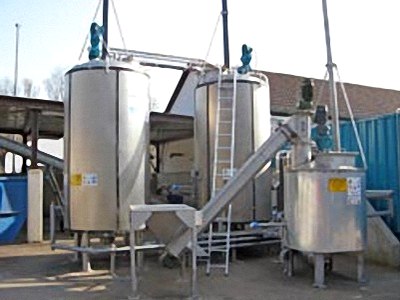Producing electricity from ... straw
Researchers have developed an unprecedented biogas plant that runs entirely with agricultural waste: Straw. The plant will produce 30% more biogas than previous plants.

Factory testing electricity production . straw
"Corn is food, not biogas" - more and more people say it, in general, the scientific community often opposes the use of food fermentation to biogas, and from there generate electricity and heat.
It is feared that applying this process will escalate food prices.
However, in collaboration with many small and medium-sized enterprises, researchers of the Institute of Ceramics Technology and IKTS system in Dresden (Germany) have implemented an unprecedented biogas plant completely untouched. Food.
'At our test plant, we use only agricultural residues such as corn cobs and wheat straw without using seeds. With this low-value raw material we have produced biogas with 30% more efficiency than traditional technologies' - Michael Steller. Head of IKTS department said.

Raw materials - straw or corn cobs - are an unlimited source
The benefits of the new process are not only that. Time to disintegrate waste (incubation process) at the plant can be reduced by 50 to 70%. Biomass is usually stored in fermentation devices to generate biogas for 80 days. By finding a pre-treatment method, incubation in the experimental plants of the group of scientists mentioned above takes only 30 days. 'Corn (or straw) containing cellulose is not directly fermented. But in our factory, cellulose is degraded by enzymes before incubation ' . Steller explained.
The researchers also optimized the process of converting biogas into electricity, which converts gas to a high-temperature fuel cell with a conversion efficiency of 40 to 55 percent. Meanwhile, the engines used for this purpose only achieve an average efficiency of 38% because heat is difficult to convert into electricity.
In addition, because fuel cells operate at 850 degrees Celsius, it is possible to directly utilize heat to heat or provide heating networks in cities. If combined with electrical and thermal efficiency, the fuel cell will achieve a general efficiency of up to 85%, while the performance of the conventional engine will not exceed the 38%.
The test plant has a capacity of 1.5 kilowatts, enough to meet a household's energy needs. Researchers will present their perspectives and research results at the Hanover Fair held April 20 to 24 this year. The next phase of the project, according to scientists, is to coordinate with industry partners to raise the scale to 2 megawatts.
- Cheap straw collectors
- Turn straw into money
- New fuel from straw
- Japan has the technology to produce cheap fuel from straw
- Japan supports the development of technology to produce electricity from the universe
- Straw mushroom: Instructions for planting and harvesting
- Producing wind power and solar power is cheaper than coal
- Producing electricity with snails
- Why do farmers burn straw?
- High-tech house walls
- Trichoderma is capable of treating rice straw in the field
- Producing biofuel from dry straw and trees
 Why do potatoes have eyes?
Why do potatoes have eyes? 'Tragedy' the world's largest carnivorous life: Death becomes ... public toilet
'Tragedy' the world's largest carnivorous life: Death becomes ... public toilet Tomatoes were once considered 'poisonous' for 200 years
Tomatoes were once considered 'poisonous' for 200 years Detecting microscopic parasites on human face
Detecting microscopic parasites on human face